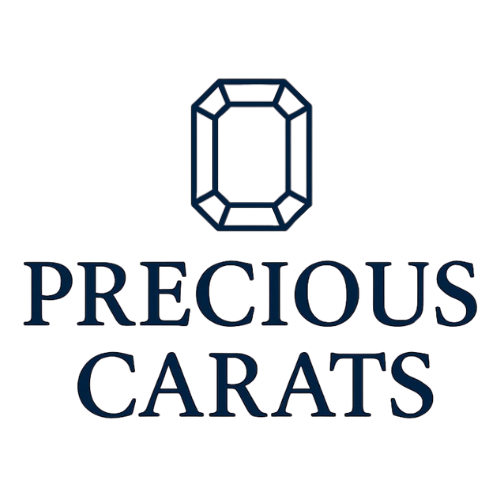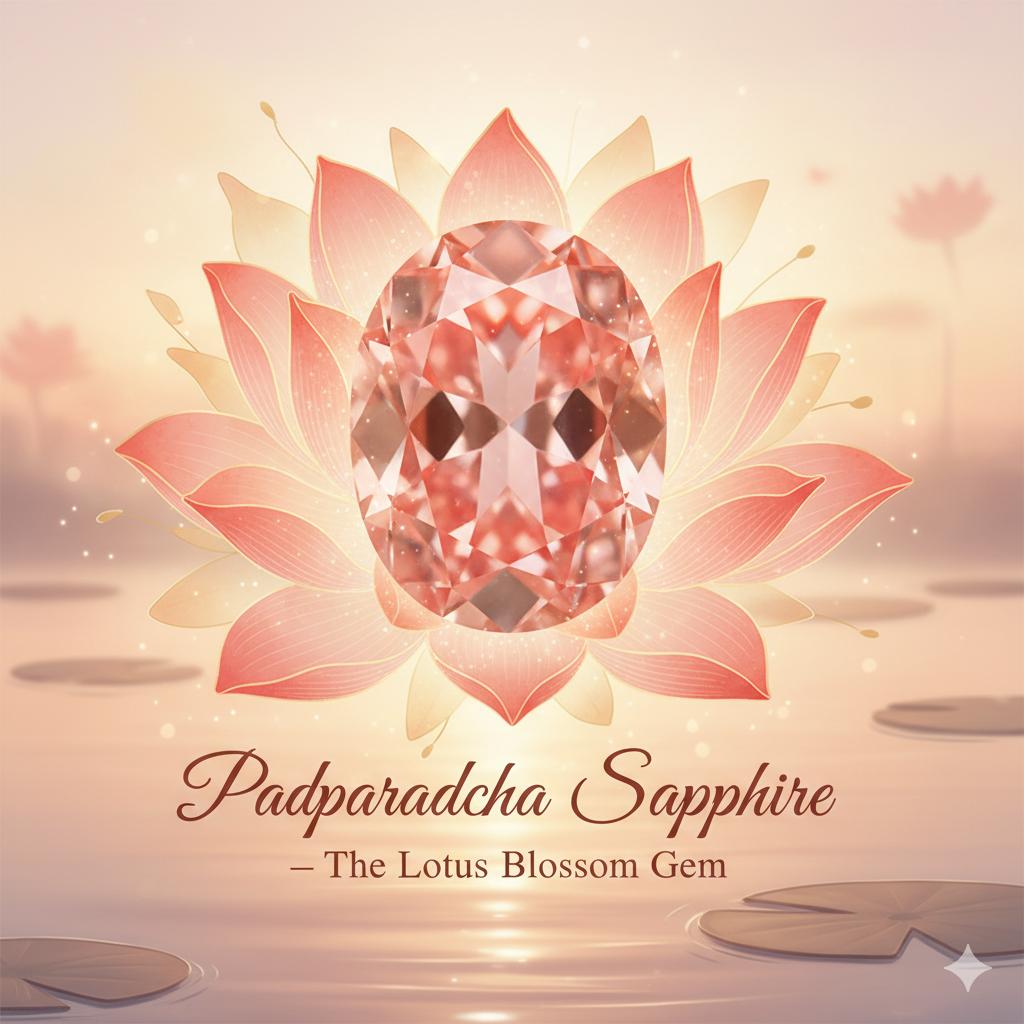Introduction
Padparadscha sapphire is one of the rest and most enchanting gemstones in the world. Its name comes from the Sinhalese word ‘Padmaraga,’ meaning lotus blossom, a perfect description of its delicate pinkish-orange hue. Unlike other sapphires that are simply blue, yellow, or pink, Padparadscha sapphires exist in a delicate balance between pink and orange. They are often compared to the glow of a tropical sunset or the bloom of a lotus flower on still waters. Extremely rare, they represent less than 1% of all sapphires mined globally, making them one of the most desirable collector’s gems.
This blog explores the Padparadscha sapphire in depth — from its gemological identity, history, and rarity to its astrological significance, market value, and cultural symbolism. By the end, you will understand why this gemstone is often called the ‘holy grail’ of sapphires.
Gemmological Identity of Padparadscha
Padparadscha belongs to the corundum family, just like all sapphires and rubies. What makes it unique is the exact mix of trace elements that create its lotus-inspired colour. Chromium gives a pink tint, while iron contributes orange tones. When perfectly balanced, they produce the sunset or lotus flower hue that defines Padparadscha.
Key features include:
– Colour: A balance of pink and orange; too pink becomes ‘pink sapphire’ and too orange becomes ‘orange sapphire.’
– Hardness: 9 on the Mohs scale, making it durable for jewellery.
– Treatments: Many Padparadschas are heat-treated to improve clarity and balance colour. Some are diffusion-treated with beryllium, which significantly reduces value.
– Sources: Sri Lanka (classical, most prized), Madagascar (modern, significant source), Tanzania (occasional).
History and Lore
The history of Padparadscha sapphire is rich and exotic. Ancient Sinhalese traders recognized its lotus colour and considered it a gem of kings. Sanskrit texts referred to it as ‘Padmaraga,’ meaning lotus-coloured jewel, placing it among the most sacred stones. In Mughal courts and royal Sri Lankan treasuries, Padparadscha was considered rarer and more precious than rubies and emeralds.
In Europe, collectors during the Victorian era hunted for Padparadscha sapphires, fascinated by their sunset-like colours. Even today, auction houses such as Christie’s and Sotheby’s feature Padparadscha sapphires as highlights in their catalogues. Their rarity has given them a reputation as one of the ‘holy grail’ gems of the jewellery world.
Rarity and Market Value
Padparadscha sapphires are rarer than even Kashmir blue sapphires in fine quality. Their rarity arises from the need for a perfect balance of pink and orange — too much of one and the stone loses its identity.
Market value is influenced by:
– Colour: Balanced pink-orange is ideal; brownish or overly light stones fetch less.
– Origin: Sri Lankan stones are the most prized, with Madagascar as the modern source.
– Size: Stones above 2 carats are rare, and anything over 5 carats is considered museum-grade.
– Treatment: Untreated Padparadscha stones carry massive premiums.
Examples of auction sales:
– A 28-carat Padparadscha sapphire was sold by Christie’s for over $2.5 million.
– Even smaller, certified 2–3 carat stones can sell for tens of thousands of dollars.
This rarity makes Padparadscha sapphires coveted among collectors, rivaling Paraiba tourmalines, pigeon blood rubies, and Colombian emeralds.
Padparadscha vs. Other Sapphires
Unlike pink or orange sapphires, which lean heavily to one side of the spectrum, Padparadscha is defined by its balance. Laboratories like GIA, SSEF, and Lotus Gemology have strict definitions of what qualifies as a Padparadscha sapphire. Many stones sold under this name are actually pinkish-orange sapphires that do not meet the laboratory criteria.
The fine line between Padparadscha and other sapphires adds to the mystique and difficulty of purchasing. It requires both expertise and certification to ensure authenticity.
Astrological Significance
Padparadscha sapphire is not one of the classical Navratna stones, but modern astrologers sometimes assign it to Venus (Shukra) or Jupiter (Guru), depending on the tradition. Its unique dual-tone makes it a symbol of balance, creativity, and harmony.
Beliefs include:
– Enhances creativity and artistic talent.
– Promotes romance, grace, and harmony in relationships.
– Brings emotional stability and reduces stress.
– Considered a safe gemstone, unlike Blue Sapphire, which can have intense effects.
Famous Padparadscha Sapphires
Padparadscha sapphires occasionally make headlines:
– Princess Eugenie of the British royal family wears a Padparadscha sapphire engagement ring.
– Auction houses frequently feature them as top lots, commanding six or seven-figure prices.
– Private collectors in Asia, especially Japan and Sri Lanka, have a long tradition of valuing Padparadscha sapphires above rubies and emeralds.
These examples show how Padparadscha remains a gemstone of prestige, rarity, and romance.
Buyer’s Guide for Padparadscha Sapphires
When buying Padparadscha sapphires, extra caution is necessary due to widespread mislabeling and treatments. Key points include:
– Always demand certification from a reputed lab (GRS, SSEF, Lotus, GIA).
– Check for colour balance — true Padparadscha is neither too pink nor too orange.
– Prefer untreated stones; heat-treated stones are acceptable but worth less.
– Be wary of beryllium diffusion, which artificially creates Padparadscha-like hues.
– Understand pricing: Sri Lankan origin > Madagascar > Tanzania.
Padparadscha is not typically suggested for casual buyers; it is best suited for serious collectors or connoisseurs of fine gemstones.
The Emotional and Poetic Essence of Padparadscha
Padparadscha sapphire is often described as a sunset captured in stone. Its dual tones represent harmony between passion (pink) and vitality (orange). In Hindu and Buddhist traditions, the lotus is a symbol of purity, enlightenment, and serenity. Thus, the Padparadscha embodies beauty rising from adversity, much like a lotus that blooms untouched from the mud.
This makes Padparadscha a deeply symbolic gemstone — ideal for engagement rings, bridal jewellery, and heirlooms. It is a celebration of love, balance, and grace.
Conclusion
Padparadscha sapphire is truly one of nature’s masterpieces. With its delicate lotus-blossom hue, rich cultural history, and extraordinary rarity, it stands apart from all other gemstones. Neither fully pink nor fully orange, it is a gem of balance and harmony, often commanding some of the highest prices in the sapphire family.
For collectors, Padparadscha represents a pinnacle of connoisseurship. For wearers, it brings romance, serenity, and prestige. Whether seen as an astrological remedy, an investment, or simply a jewel of beauty, Padparadscha sapphire remains one of the most poetic and sought-after gems in the world.

